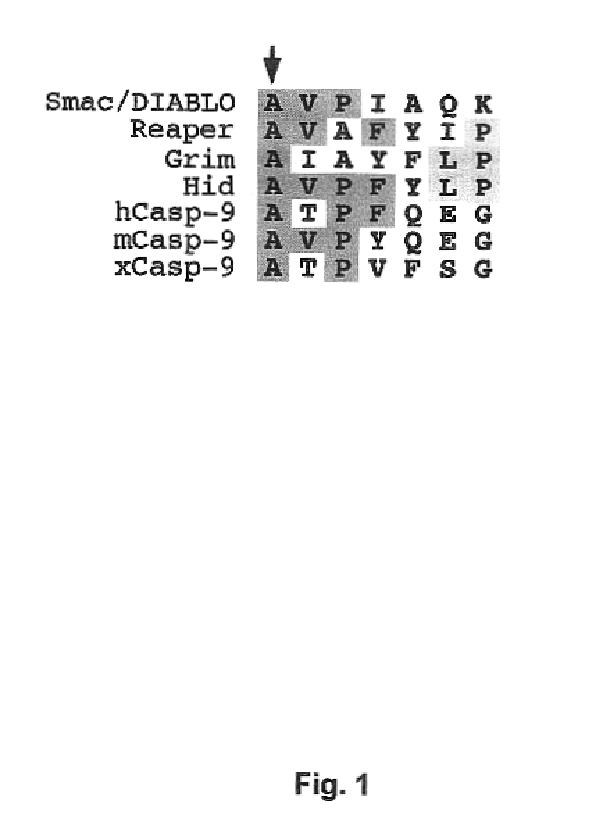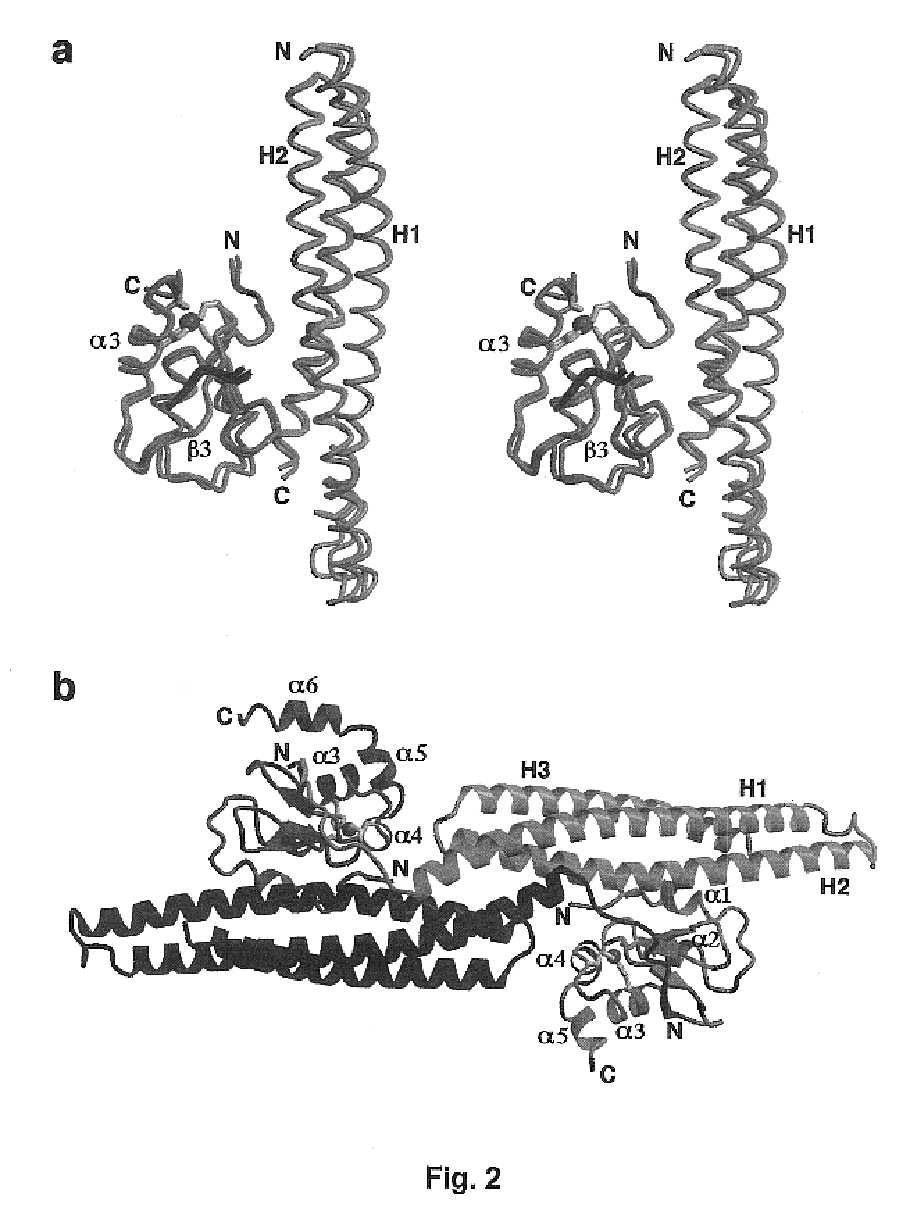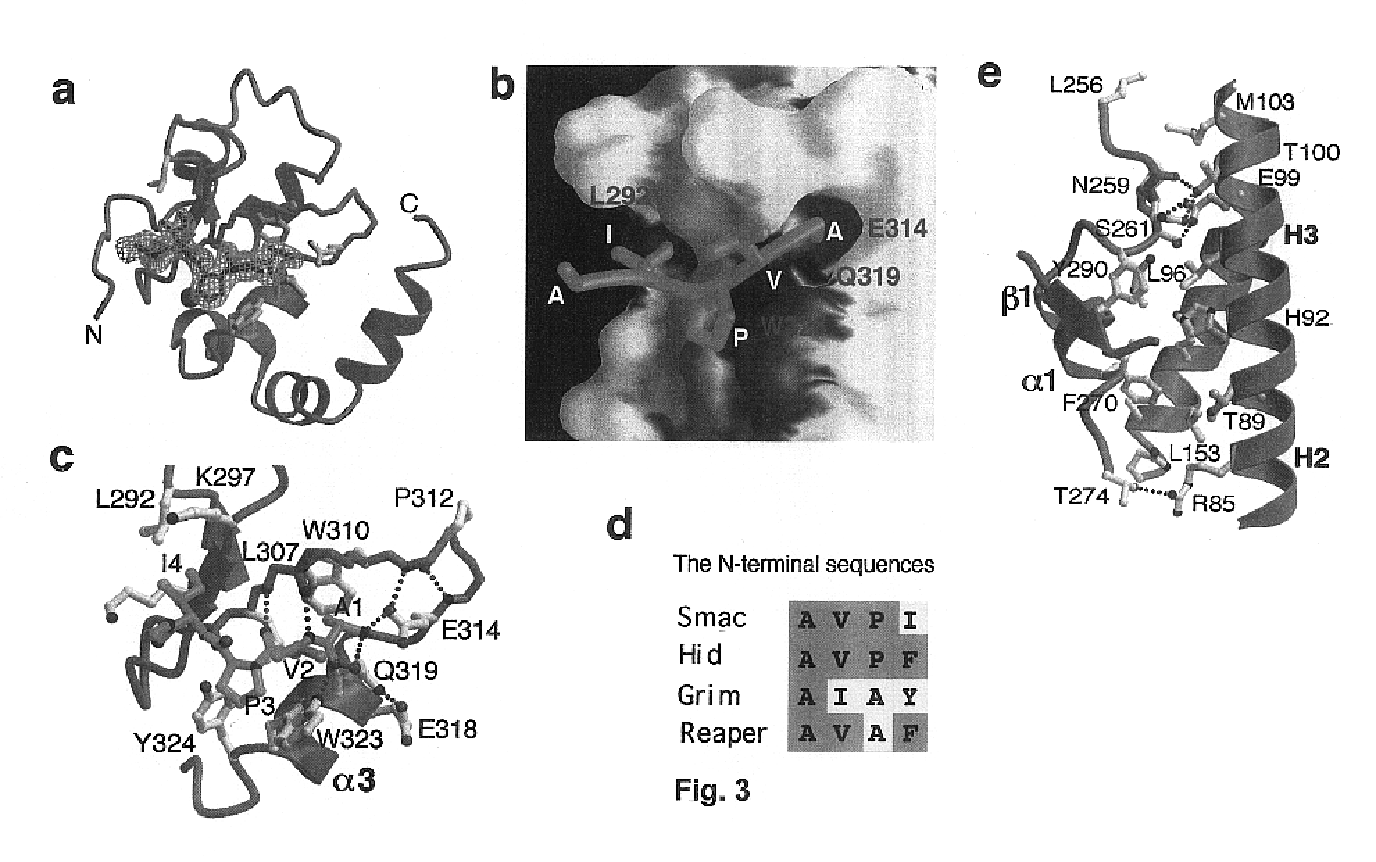Compositions and method for regulating apoptosis
a technology of apoptosis and composition, applied in the field of cell biology and cell proliferation control, can solve the problems of lack of molecular specificity of therapies, lack of precise structural information, and patents that neither disclose nor teach structural bases, so as to relieve xiap-mediated suppression of apoptosis, suppress programmed cell death, and relieve the effect of suppression
- Summary
- Abstract
- Description
- Claims
- Application Information
AI Technical Summary
Benefits of technology
Problems solved by technology
Method used
Image
Examples
example 1
Structural Basis of IAP Recognition by Smac
[0087]All members of the IAP family contain at least one BIR (baculoviral IAP repeat) motif and many contain three. Recent experiments indicate that different BIR domains may exhibit distinct functions. The second BIR domain (BIR2) of XIAP is a potent inhibitor for caspase-3 whereas XIAP-BIR3 primarily targets the active caspase-9. Smac is synthesized as a precursor molecule of 239 amino acids; the N-terminal 55 residues serve as the mitochondria targeting sequence that is removed after import. The wild-type Smac protein (residues 1-184) forms a dimer in solution and interacts with both the BIR2 and BIR3 domains of XIAP. Point mutations at the dimeric interface, such as Phe33Asp, completely inactivate dimer formation. Such monomeric mutants can no longer interact with XIAP-BIR2; but they retain binding to the BIR3 domain. A missense mutation of the N-terminal Ala residue to Met (Ala1Met) in wild-type Smac abolishes binding to both the BIR2 ...
example 2
Structural Analysis of a Functional DIAP1 Fragment Bound to Grim and Hid Peptides
[0108]The Inhibitor of Apoptosis protein DIAP1 suppresses apoptosis in Drosophila, with the second BIR domain (BIR2) playing an important role. Three proteins, Hid, Grim, and Reaper, promote apoptosis, in part by binding to DIAP1. Although Hid, Grim and Reaper perform a similar function in promoting cell death, they only share homology in the N-terminal 14 residues of their primary sequences (Chen et al., Genes Devel. 10, 1773-1782, 1996). These N-terminal sequences are sufficient to mediate interactions with DIAP1 (Vucic et al., Proc. Natl. Acad. Sci. USA 94, 10183-10188, 1998) and with several mammalian IAPs (McCarthy and Dixit, J. Biol. Chem. 273, 24009-24015, 1998). In the case of Hid in insects, and Hid and Reaper in mammalian cells, these N-terminal sequences are essential for pro-apoptotic function.
[0109]To investigate the structural mechanisms of DIAP1 recognition by the Drosophila Hid, Grim and...
example 3
Crystallography of a Functional DIAP1 Fragment Bound to Veto Peptide
[0131]Using methods similar to those set forth in the previous example, the DIAP1-BIR2 domain in complex with the N-terminal portion of the proapoptotic Drosophila protein Veto was crystallized and its structure analyzed. Crystallographic data and comparative data with respect to the Smac / XIAP interaction are set forth in Table 5 and Table 6 below.
[0132]
TABLE 5Data collection and statistics from the crystallographic analysisData setDIAP-BIR2 / Veto peptideResolution (Å)99.0-2.1Total observations255,868Unique observations9,075Data coverage (outer shell)95.8% (94.1%)Rsym (outer shell)0.052 (0.145)RefinementResolution range (Å)20.0-2.1Number of reflections8881Rworking / Rfree21.5% / 28.4%Number of atoms1002Number of waters116R.m.s.d. bond length (Å)0.009R.m.s.d. bond angles (degree)1.472Rsym = ΣhΣi|Ih,i-Ih| / ΣhΣiIh,i, where Ih is the mean intensity of the i obervations of symmetry related reflections of h. R = Σ |Fobs-Fcalc|...
PUM
| Property | Measurement | Unit |
|---|---|---|
| Fraction | aaaaa | aaaaa |
| Fraction | aaaaa | aaaaa |
| Fraction | aaaaa | aaaaa |
Abstract
Description
Claims
Application Information
 Login to View More
Login to View More - R&D
- Intellectual Property
- Life Sciences
- Materials
- Tech Scout
- Unparalleled Data Quality
- Higher Quality Content
- 60% Fewer Hallucinations
Browse by: Latest US Patents, China's latest patents, Technical Efficacy Thesaurus, Application Domain, Technology Topic, Popular Technical Reports.
© 2025 PatSnap. All rights reserved.Legal|Privacy policy|Modern Slavery Act Transparency Statement|Sitemap|About US| Contact US: help@patsnap.com



